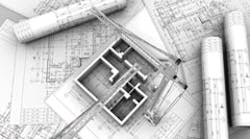in today’s economic climate, almost every state has cut its education budget. A tumultuous stock market has resulted in reduced income from endowments, and less government-funded research is available. Education institutions are making painful cuts and must provide value for every dollar spent.
Education institutions with large campuses are exploring how building information modeling (BIM) can help them design and construct more efficient buildings more quickly and maintain them for less cost. Those education institutions that have dipped a toe into the BIM pool have experienced increased efficiencies and millions in cost savings. Given the newness of the technology, some education institutions have been hesitant to establish BIM guidelines and standards, but they shouldn’t be.
Save time and costs
BIM is a modeling process that enables a designer to visualize a building completely before it is built. It provides a detailed view of spatial relationships, light analysis, geographic information, quantities and properties of building components—including mechanical and structural systems—all at once with the click of a mouse. In short, BIM enables designers, architects and education institutions to simulate construction and performance before breaking ground.
With BIM, one can see how moving a wall affects the mechanical and structural systems, not to mention project costs, well before the wall actually is moved. All disciplines work simultaneously in one virtual model in real time, and design and construction can be tracked almost parallel to each other. Because 40 percent to 50 percent of building cost is labor, BIM has a tremendous capability to influence time of completion. When the building schedule is advanced, costs are reduced. The technology also reduces costly change orders.
BIM enables designers and architects to understand the variables that affect energy consumption by simulating energy performance in the early stages of building design. This feature is important because rising energy costs require that education facilities operate at peak performance and efficiency. Designers can run calculations to show the effect that specific variables such as daylighting and window sizes and ratings can have on the quality of the space and the energy loads of the building. These simulations help designers create buildings that are more energy-efficient and sustainable. Owners can realize the potential for as much as a 20 percent to 30 percent reduction in energy when using BIM.
Untapped opportunities
Aging technologies and the lack of good data create inefficiencies in today’s maintenance processes. Many education institutions have stacks of drawings stored somewhere on campus. Such paperwork often can take hours to find and is difficult to keep current. In contrast, with BIM, all information, including manuals, maintenance schedules and schematics for all equipment and components, is readily accessible in one virtual location.
Inaccurate information wastes time, energy and dollars. A report from the National Institute of Standards and Technology indicates that $15.8 billion is lost each year because of inefficient data exchange during the design, construction, facilities management and operations of large commercial, institutional and industrial buildings, facilities and plants. Furthermore, research reports that owners and operators linking BIM and facilities-management software on existing facilities can save in excess of 25 to 35 cents per square foot per year through energy management, asset management, improved interoperability, strategic facilities management, reduced custodial costs and capital replacement.
Here’s an example of how BIM can decrease operating costs: Typically, if a maintenance technician receives a request to service a building’s air-conditioner unit, he or she first visits the site to confirm that the unit needs repair. Back at the office, the technician locates the relevant manuals and information, grabs his or her tools and returns to the site to repair the unit.
The maintenance technician handles the request differently in a BIM environment. After receiving the call, he or she logs into the BIM system and can see performance metrics in real time. The technician can confirm the unit is down and even diagnose the problem without leaving the office.
He or she also sees two other maintenance issues in the same building. The technician accesses the relevant information, loads the required tools and completes all the service requests in one trip, significantly bringing down the cost equation.
One major West Coast institution estimated that if it could cut wasted maintenance trips in half, it could save an estimated $2 million per year. It’s easy to see that having all the relevant mechanical and component information in one central repository can have long-term benefits far beyond design and construction.
Carrying out BIM
Using BIM has obvious financial and efficiency benefits, but it requires commitment. Education institutions interested in moving to a BIM environment should determine first what they want to achieve through such a system.
As a second step, they should define those people who need access to the information about the building and how they intend to use the information. Individuals could range from the executives needing budget information to the operations and maintenance staff. Each would use BIM differently, so the information requirements of each of these groups and their tasks must be defined.
This isn’t a subtle change, and it might require outside help. Education institutions engaging an external resource should look for providers that have demonstrated expertise in a BIM environment, from conceptual design through construction. The provider should be capable of integrating all disciplines (architecture, electrical, mechanical, plumbing, etc.) and have a working understanding of how BIM can be applied to facility management and operations.
For those who are stewards of public funds, BIM helps them get every bit of value out of each dollar. Leveraging BIM is not just about switching software; it requires a huge mental shift from all parties about the way buildings are designed, constructed and operated. In this economy, the owners are in the driver’s seat, and the opportunity is better than ever to incorporate BIM and influence how design is delivered.
Sidebar: Indiana University leads the way
In October 2009, Indiana University (IU) decided to create building information modeling (BIM) standards. IU has eight campuses, 825 buildings, more than 100,000 students, and was one of the first major institutions to move from a traditional project-delivery approach to a BIM environment. IU recognized the value that BIM could bring in terms of better design and building collaboration, lower costs, and improved energy conservation and facilities management. Now, BIM is part of its standard contract structures.
The first phase of IU’s effort was to develop the university’s “BIM Guidelines and Standards for Architects, Engineers and Contractors” in order to support IU’s facility design, construction and management needs. The planned second phase is to extend its BIM-based building design data to improve operations and facilities management. During the process of developing guidelines, a matrix was developed to help understand the marketplace’s proficiency and evaluate firms, especially when two firms appeared equal. It also was an education tool for IU to show the marketplace what it really wanted to accomplish.
IU’s “BIM Execution Plan” defined the roles, responsibilities and specific tasks of each team member participating in the BIM model for the purpose of the design and construction of a given project. It is a required contract document that defines deliverables, reporting and completion dates. IU’s “Integrated Process Delivery Plan” documents the proposed methods the design team (including the owner) must use to demonstrate increased integration of the design and construction processes from design concept through project completion.
IU believes the application of BIM principles can help sustain its place in the community, underscore its commitment to stewardship of public funds and enhance its commitment to sustainable design for the future. Now that IU is using BIM, several large education institutions have approached it about doing the same thing.
Phillips is the director of technology and BIM services at SHP Leading Design, a Cincinnati-based architecture firm and leader in building information modeling, energy and daylight modeling and building for LEED. His blog, www.bimreality.com, discusses cutting-edge ideas surrounding BIM, using an integrated project delivery (IPD) and BIM process, and looks for ways to link facilities' database models. He can be reached at [email protected].


